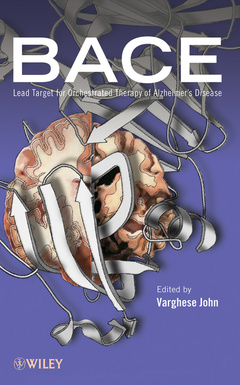BACE Lead Target for Orchestrated Therapy of Alzheimer's Disease
Auteur : John Varghese

BACE (?-site of APP cleaving enzyme) is a critical component in Alzheimer's Disease (AD), and the development of BACE inhibitors shows great potential as a therapy for the disease. BACE: Lead Target for Orchestrated Therapy of Alzheimer's Disease covers virtually all aspects of BACE from initial identification, discovery of inhibitors, and challenges in clinical development, while providing a global understanding essential for productive and successful drug discovery.
This book details the story of the discovery of BACE and its role in AD and comprehensively discusses:
The development of BACE inhibitors as therapeutics for Alzheimer's disease
The research that led to the identification of BACE
New BACE inhibitors currently being clinically tested
ADME (absorption, distribution, metabolism, excretion) and clinical trial design?topics not addressed in current field literature
Cutting-edge technology such as high-throughput screening, structure-based drug design, and QSAR in context of BACE inhibitors and Alzheimer's drug discovery
Other approaches to BACE inhibition based on interaction with the precursor protein APP
By enhancing the reader's understanding of the various aspects of the BACE drug-discovery process, this much-needed reference will serve as a key resource for all scientists involved in Alzheimer's research?and inspire new approaches to treatment of AD.
ACKNOWLEDGMENTS.
CONTRIBUTORS.
CHAPTER 1 BACE, APP PROCESSING, AND SIGNAL TRANSDUCTION IN ALZHEIMER'S DISEASE (Dale E. Bredesen and Edward H. Koo).
1.1 Introduction.
1.2 BACE Cleavage of APP as a Molecular Switching Mechanism.
1.3 AD: An Imbalance in Cellular Dependence?
1.4 BACE Cleavage, Caspase Cleavage, and Neuronal Trophic Dependence.
1.5 BACE Cleavage of APP, Dependence Receptors, and Alzheimer Pathology.
1.6 Key Mutations Proximal of APP Processing to Aβ.
1.7 Final Remarks.
CHAPTER 2 IDENTIFICATION OF BACE AS A TARGET IN ALZHEIMER'S DISEASE (Robert L. Heinrikson and Sukanto Sinha).
2.1 Introduction.
2.2 The Search for β-Secretase.
2.3 Validation of the BACE Target.
2.4 Final Remarks.
CHAPTER 3 BACE BIOLOGICAL ASSAYS (Alfredo G. Tomasselli and Michael J. Bienkowski).
3.1 Introduction.
3.2 Clinical and Physiological Hallmarks of Alzheimer’s Disease (AD).
3.3 APP Processing.
3.4 Aspartyl Protease Classification.
3.5 BACE Structure.
3.6 Mechanism, Kinetics, Inhibition, and Specificity.
3.7 Assay Strategies for Inhibitor Finding and Development.
3.8 Common Assays Used to Identify and Study Inhibitors.
3.9 BACE Assays.
3.10 Final Remarks.
CHAPTER 4 PEPTIDIC, PEPTIDOMIMETIC, AND HTS-DERIVED BACE INHIBITORS (James P. Beck and Dustin J. Mergott).
4.1 Introduction.
4.2 Elan/Pharmacia (Pfizer).
4.3 Oklahoma Medical Research Foundation (OMRF)/Multiple Collaborators.
4.4 Eli Lilly.
4.5 Merck.
4.6 GlaxoSmithKline.
4.7 Schering Plough.
4.8 Bristol-Myers Squibb.
4.9 Novartis.
4.10 Amgen.
4.11 Wyeth.
4.12 Final Remarks.
CHAPTER 5 FRAGMENT-BASED APPROACHES FOR IDENTIFICATION OF BACE INHIBITORS (Andreas Kuglstatter and Michael Hennig).
5.1 Introduction.
5.2 Biophysical Methods Applied to BACE Fragment Screens.
5.3 BACE Inhibitors Identified by Fragment Screening.
5.4 Final Remarks.
CHAPTER 6 STRUCTURE-BASED DESIGN OF BACE INHIBITORS: TECHNICAL AND PRACTICAL ASPECTS OF PREPARATION, 3-DIMENSIONAL STRUCTURE, AND COMPUTATIONAL ANALYSIS (Felix F. Vajdos, Veerabahu Shanmugasundaram, and Alfredo G. Tomasselli).
6.1 Introduction.
6.2 Preparation of BACE for Structural Studies.
6.3 Crystallographic Studies of BACE.
6.4 Structural Studies with BACE Inhibitors: Peptidomimetics and Nonpeptidomimetics.
6.5 Computational Approaches.
6.6 Final Remarks.
CHAPTER 7 PHARMACOLOGICAL MODELS FOR PRECLINICAL TESTING: FROM MOUSE TO DOG TO NONHUMAN PRIMATES (Jason L. Eriksen, Michael Paul Murphy, and Elizabeth Head).
7.1 Introduction.
7.2 BACE1 and Mouse Models of AD.
7.3 Testing BACE Inhibitors in the Canine Model of Human Aging and AD.
7.4 BACE Inhibitors and Nonhuman Primates.
7.5 Final Remarks.
CHAPTER 8 ADSORPTION, DISTRIBUTION, METABOLISM, EXCRETION (ADME), EFFICACY, AND TOXICOLOGY FOR BACE INHIBITORS (Ishrut Hussain and Emmanuel Demont).
8.1 Introduction.
8.2 Development of BACE Inhibitors with Optimized ADME Properties.
8.3 In Vivo Efficacy of BACE Inhibitors.
8.4 Toxicology of BACE Inhibitors.
8.5 Final Remarks.
CHAPTER 9 CLINICAL TRIALS FOR DISEASE-MODIFYING DRUGS SUCH AS BACE INHIBITORS (Henry H. Hsu).
9.1 Introduction.
9.2 Update on Beta-Amyloid Therapies in Clinical Development.
9.3 Clinical Development of BACE Inhibitors and Other Disease-Modifying Drugs.
9.4 Final Remarks.
CHAPTER 10 FUTURE STRATEGIES FOR DEVELOPMENT OF NOVEL BACE INHIBITORS: ANTI-APP β-SITE ANTIBODY AND APP BINDING SMALL MOLECULE APPROACHES FOR ALZHEIMER'S DISEASE (Beka Solomon, Michal Arbel-Ornath, Clare Peters-Libeu, and Varghese John).
10.1 Introduction.
10.2 β-Secretase: Discovery, Function, and Inhibitors.
10.3 Generation of Aβ Peptides via the Endocytic Pathway.
10.4 Generation of Anti-APP β-Site Antibodies.
10.5 Antibody Interference with Aβ Production in Cellular Model.
10.6 Antibody Interference with Aβ Production in Animal Models.
10.7 Identification of APP Binding Small Molecules that Block β-Site Cleavage of APP.
10.8 Final Remarks.
AFTERWORD (Ruth Abraham).
Introduction.
Artwork as a Measure of the Progression of AD.
INDEX.
Date de parution : 03-2010
Ouvrage de 288 p.
16.3x24.1 cm



